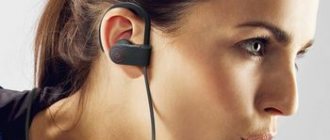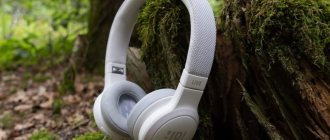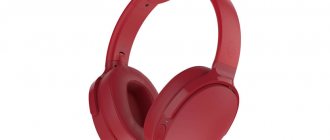They are used to get rid of the noise in the subway while commuting to work, not to hear the noise of an airplane engine, or to stay with only your thoughts on the bus.
There are many models of such devices on the market, so choosing the best noise-canceling headphones is quite difficult.
To make your choice easier, we have made a rating of noise-canceling headphones and included models in the price/quality ratio that are optimal in 2021.
The review is based on real consumer reviews and expert assessments.
Rating of the TOP 20 best wireless noise-canceling headphones of 2021
| Place | Name | Price |
| TOP 3 best wireless noise-cancelling headphones in price/quality ratio for 2021 | ||
| 1 | Sennheiser Momentum True Wireless 2 | Find out the price |
| 2 | HONOR Magic Earbuds | Find out the price |
| 3 | Sony WH-1000XM4 | Find out the price |
| TOP 3 best in-ear wireless noise-canceling headphones | ||
| 1 | Apple AirPods Pro | Find out the price |
| 2 | HUAWEI FreeBuds Pro | Find out the price |
| 3 | Sony WF-1000XM3 | Find out the price |
| TOP 3 best over-ear wireless noise-cancelling headphones | ||
| 1 | Marshall Mid ANC | Find out the price |
| 2 | Harman/Kardon FLY ANC | Find out the price |
| 3 | Sony WH-CH710N | Find out the price |
| TOP 3 best full-size wireless noise-canceling headphones | ||
| 1 | Sony WH-1000XM3 | Find out the price |
| 2 | Bose Quiet Comfort 35 II | Find out the price |
| 3 | Beats Studio 3 Wireless | Find out the price |
| TOP 3 Best Wireless Noise Canceling In-Ear Headphones | ||
| 1 | Samsung Galaxy Buds Live | Find out the price |
| 2 | HUAWEI FreeBuds 3 | Find out the price |
| 3 | QCY T8 | Find out the price |
| TOP 3 best wireless noise-canceling headphones with microphone | ||
| 1 | Sony WH-XB900N | Find out the price |
| 2 | HUAWEI FreeBuds 3i | Find out the price |
| 3 | JBL Tune 600BTNC | Find out the price |
| TOP 2 best inexpensive wireless noise-canceling headphones | ||
| 1 | Bluedio T4 | Find out the price |
| 2 | JBL Tune 750BTNC | Find out the price |
Bose Quiet Comfort 35 II
The Bose QuietComfort 35 II is the manufacturer's current flagship model of wireless over-ear headphones. As you might guess, this is an updated version of the Bose QuietComfort 35 headphones, about which one could say that these are the best wireless headphones with active noise cancellation, but I will not draw any analogies since I did not use the first generation and cannot physically compare. In addition to active noise reduction, the model is interesting because it has official support for Google Assistant. Neither Ukrainian nor Russian languages have been introduced into Google Assistant yet, but everyone who is interested and curious can use English.
What do they look like and what's in the box?
The packaging and delivery are similar to the previous model in our article. The box is medium in size, with an outer “wrapper” made of soft white cardboard with printing, and a black box made of hard cardboard inside. The set includes headphones, a hard case, a charging cable, a cable for a wired connection and a small instruction brochure:
The headphones are made of plastic and metal (frame), the design is foldable, like the Sony WH-1000XM3. The cups are rotating, their outer part is plastic and painted with matte paint. It looks expensive and beautiful, but it collects fingerprints. Microphones for active noise reduction and Bose logos are located on the outer parts of the cups. To turn on and create a Bluetooth pairing mode, there is a slider switch on the right earphone. On the front there is a conversational microphone and an NFC tag. On the back are three mechanical playback control buttons with two LEDs next to them. Below is MicroUSB for charging. The left earphone has a connector for a wired connection and a large button for calling Google Assistant. It can be reassigned, which I did right away; as a result, it was used to switch noise reduction operating modes. The inside of the headband has a soft Alcantara insert. The ear pads are soft, with memory foam on the inside and leatherette on the outside. Inside the cups are the designations of the left and right earbuds. The headset turned out to be light, despite this, it does not feel cheap or unreliable. We have a black version, but there is also a silver version.
How convenient is it to use?
The headset is very light and comfortable, the clamping force of the headband is optimal. Bose QuietComfort 35 II can be used for hours without removing it without any discomfort. The ears fit completely inside the ear pads. Nothing presses, does not interfere, the headset perfectly adapts to the shape of the head. The ears do not sweat, although it is not summer yet and there are suspicions that this may change a little in the heat, but it is worth checking in practice. In general, of the trio of heroes in the article, the Bose QuietComfort 35 II seemed to me the most comfortable. It’s very easy to get used to the controls: there are only three buttons on the right earpiece. The two extreme ones are responsible for the volume, the middle one is multifunctional: click - Play/Pause, double click - the next track, triple click - the previous track, and is also responsible for answering/hanging up a call. The design of the headphones is foldable for easy transportation, and a MicroUSB connector is used for charging.
There is a proprietary Bose Connect application, in which you can change the name of the headset, switch between sources, adjust the noise reduction level, reassign the Google Assistant button, view current data on the charge, volume and track being played (including pulling up information from Google Music) and enable voice prompts . There is already a Russian-language localization, albeit crooked, with a funny accent:
What about sound, noise cancellation and battery life?
Perhaps the weakest point of the headset is the sound. No, it's not bad (especially considering that it's a Bluetooth headset). In general, for its category of gadgets, the sound is quite good, but worse than the other two models in this material. In terms of frequencies, the low frequencies are slightly raised, but not critically. Otherwise, there are no pronounced peaks or dips, but detail suffers greatly across the entire frequency range: some “cloudness” and blurriness are felt. In terms of sound, the Bose QuietComfort 35 II is optimal for creating a musical background, rather than attentive and thoughtful listening to music, which is quite forgivable. It's worth mentioning that Bose fundamentally still doesn't use aptX or aptX HD. It is sad.
Given Bose's track record of active noise cancellation, it's no surprise that the QuietComfort 35 II's noise reduction works great. In this regard, the Bose and Sony models are comparable: you can listen to music comfortably and comfortably even in a noisy metro. There are three modes of noise reduction: maximum (just for the metro and other extremely noisy places), medium, which is quite suitable for walking. Plus, active noise cancellation can simply be turned off. There were no complaints about the built-in microphone; it performs its functions without problems both indoors and outdoors.
The declared operating time in wireless mode with noise reduction function is 20 hours. In real conditions, this figure depends very significantly on the volume, and I got about 17 hours, which is also very good. One charge will probably be enough for a working week of travel to and from work. Charges in about 2 hours.
Bose Quiet Comfort 35 II
An updated model of popular headphones with active noise reduction.
Lightweight and very comfortable full-size Bluetooth headphones with an active noise reduction system with three operating modes. Equipped with NFC for quick connection to a smartphone and supports Google Assistant. To enable it, there is a separate Action button, which can be reassigned in the settings.
Buy from Mvideo Buy from Svyaznoy Buy from Amazon
13,860 UAH
How to choose wireless noise canceling headphones?
When shopping for wireless noise-cancelling devices in 2021, there are a few important features to look for:
- Wearing comfort . Often such devices put pressure on the ears. You should try on the headset before buying.
- Battery life . It is better if it is at least thirty hours. This will save the battery for a long time and provide comfortable listening to music without recharging.
- Management . It can be push-button or touch-sensitive. Here everyone is guided by their own desires.
- Audio options . It is best to choose models with a frequency range from 20 Hz to 20,000 kHz.
Sennheiser PXC 550
While the Sennheiser PXC 550 isn't as environmentally responsive as some of the others on this list, it still has a few features that deserve a "smart" verdict. For example, they turn on automatically when the right capsule is unfolded from the transport position to the listening position. Accordingly, and vice versa, the Sennheiser switches off after returning to the transport position and thus saves energy.
Pairing with a smartphone is properly supported using NFC. The microcircuit is located in the left capsule, made in the form of a touchpad. This allows you to control the volume so you can skip parts you don't like. A light tapping interrupts the music to accept a phone call, which, by the way, works for both parties in excellent quality.
A slide switch in the upper right corner of the right capsule activates or deactivates two different levels of noise reduction. Level II is the highest level, where everything that is possible is hidden. There is another layer between this and the off mode: here the PXC 550 automatically adjusts to ambient noise, but not as effectively. Overall, noise reduction is almost at the same high level as that of Sony headphones.
The touchpad built into the right capsule responds instantly, which again makes work easier. However, it's even more tap-dependent than the Sony's: while a light tap is for playing and pausing music, a double tap activates the talk-through feature.
In terms of music reproduction, the Sennheisers are, as expected, in the same league as the Sony headphones, just with a slightly different voice. So there's a very slight drop off in the midrange for Sony listeners, where the Sennheiser dissolves a little better but sometimes provides a little more punch at higher frequencies.
The Sennheiser PXC 550 has different sound modes - “Club”, “Cinema” and “Speech” - they differ only in nuances. I liked the sound best when they are turned off. What Sennheiser especially likes is the fact that there are barely audible differences in sound whether the noise reduction is on or off.
Sennheiser was also convinced that they are actually not inferior in noise reduction to either s.Sony or Bose. In addition, they are much cheaper and therefore offer very good value for money.
Sennheiser PXC 550
The best sound from a renowned brand
The PXC 550 has effective noise cancellation, sounds great and is super equipped.
Buy in Svyaznoy Buy in Mvideo
10,800 UAH
Bottom line
All four headsets presented in the rating are very good, each in its own way, and which one to choose is a personal matter. Each has its own advantages and disadvantages, there is no clear favorite: the Sony WH-1000XM3 seemed to me the most interesting in sound and the most technologically advanced, plus it lasts the longest on a single battery charge. On the other hand, not everyone will like touch controls and a huge number of settings. Bose QuietComfort 35 II and Bowers & Wilkins PX are simpler and more intuitive in terms of control. The Bose model (according to personal impressions) turned out to be the most convenient, but the sound is slightly inferior to the other two models, and the lack of aptX and aptX HD is somewhat surprising. Bowers & Wilkins PX is the most unusual and interesting in design model with pleasant sound, but it lags a little behind in the implementation of the noise reduction system. I think each of the above models would be a good buy for those looking for a flagship Bluetooth headset. Surely other manufacturers also have something to show in this category, write options for your “top” in the comments.
| Sony WH-1000XM3 | Bose Quiet Comfort 35 II | Bowers & Wilkins PX | Sennheiser PXC 550 | |
| Emitters | Dynamic, 40 mm | Dynamic | Dynamic, 40 mm | Dynamic |
| Frequency range | 4 Hz - 40,000 Hz (via cable) | Manufacturer does not indicate | 10 Hz - 20,000 Hz | 17 Hz - 23000 Hz |
| Acoustic design | closed | closed | closed | closed |
| Impedance | 41 Ohm | Manufacturer does not indicate | 22 Ohm | 46 Ohm |
| Sensitivity | 103 dB | Manufacturer does not indicate | 111 dB | 110 dB |
| Charging connector | USB Type-C | MicroUSB | USB Type-C | MicroUSB |
| Bluetooth version | Bluetooth 4.2 | Bluetooth 4.1 | Bluetooth 4.1 | Bluetooth 4.2 |
| Codec support | SBC, AAC, aptX, aptX HD, LDAC | SBC | SBC, AAC, aptX, aptX HD | aptX, aptX HD |
| NFC | Eat | Eat | No | Eat |
| Weight | 255 g | 235 g | 335 g | 227 g |
Parrot ZIK. Fashionable design
Someone will say that these are just pretentious headphones that only have design, and they will be wrong. The device really stands out among its competitors with its chic design, but it also has very high-quality sound, an intonation touch control system on the right earcup, a Bluetooth module and noise reduction. The first generation model differs from its successor ZIK 2 in larger cups and weight (+55 g), the presence of five microphones and a Bluetooth 2.1 module. The sleeker and lighter new product has eight microphones, Bluetooth 3.0, and NFC. The only pity is that none of the models support the aptX and aptX Lossless codecs, so you shouldn’t count on wireless Hi-Fi. The battery lasts for 7 hours of wireless operation or 18 hours of noise reduction when the headphones are connected to a sound source with the included cable. The active noise reduction system in the first model worked as if a pillow had been lowered over your head - that is, it muffled external noise, but not completely, you could hear something. In the second generation, the noise reduction works more aggressively and effectively, although it is possible to configure it manually. Fans of fine-tuning will definitely like the proprietary application for smartphones. The sound is pleasant and universal - the entire frequency range is played clearly and without strain, but don’t expect a miracle. Although the built-in signal converter is quite good and even manages to extract good sound from a highly compressed MP3.
Buy Parrot ZIK from RUB 16,980. at Parrot.com
BOSE A20
Launching on the market back in 2010, the Bose A20 became an instant sensation thanks to its superb clarity, sound quality and unrivaled build quality. So it is not surprising that until now this headset, with the ability to connect via Bluetooth, not only does not lose its position, but is also at the very beginning of the list of the best aviation headsets on the market. Of course, not everyone can afford this model, since it is far from cheap. However, its compactness, light weight, improved noise reduction system, as well as the fact that when putting on the headphones (due to the increased internal volume of the cups) do not squeeze the auricle, are unlikely to leave indifferent those for whom money is not a problem.
MSRP: $1095
Bluetooth: Yes
Batteries: Two AA batteries
Weight: 340 gr. (12 oz.).
Connector types: dual GA, 6-pin (LEMO), U174
Warranty: 5 years
Creative Aurvana Gold. For action movies
For PC veterans, Creative is primarily associated with Sound Blaster series sound cards and speaker systems, but it also has a range of other music products, including headphones. For example, the Aurvana Gold Bluetooth headset with impressive dimensions and a very unusual design. According to good tradition, there is a Bluetooth 3.0 module and support for AAC and aptX codecs; on the right earphone there are controls for playback and telephone functions, plus, if desired, and if the battery runs out, you can use a wired connection. The battery lasts for 13 hours of playback without noise reduction, but when activated, you can count on no more than 8–9 hours. The sound is mostly concentrated in the low-frequency range - it rumbles noticeably while watching action films. The mids and highs are also present in the proper amount, especially on high-quality content, but still the bass eats away a little from the neighbors. The active noise reduction system is of average quality, cuts out only certain noise and is very similar in its operation to that of the Denon AH-NCW500. It's more likely to be there for show than to actually get rid of irritating factors when traveling.
Buy Creative Aurvana Gold for RUB 14,990 on Creative.com
Harsh reality
It's time to curb the ardor and enthusiasm of all those who have already decided to buy noise-cancelling headphones. And talk about what never ends up in manufacturers' advertising brochures.
In the Koss range, noise-cancelling models have either an external or internal microphone. The main thing is not to make a mistake when choosing
First, only the most high-tech and expensive headphones can create anything resembling complete silence. Most noise reduction systems are effective only in part of the audible frequency range. For example, on an airplane you will not hear a hum, but you will be able to understand the speech of your interlocutor without removing your headphones, or, conversely, the voice will be barely distinguishable, but high- and low-frequency noise will disturb your hearing.
Secondly, quite often the headphones themselves make noise. Yes, yes, that’s right: noise cancelers make noise. It is a fact. The noise canceling circuit is essentially an amplifier that can generate high-frequency noise that ranges from barely audible in high-end models to an audible hiss in lower-end models.
Thirdly, a change in the nature of the sound. Most noise-canceling headphones have an off button and are capable of passive operation. So, headphones with noise reduction turned on and off are two completely different models in terms of sound character. Some will see this as a plus, like two in one, while others will find it annoying. The battery runs out, and instead of a refined, light sound, we get a bass drone.
Bose headphones used to have a built-in battery, but newer models are powered by AAA batteries
Fourthly, this is nutrition. All active noise canceling headphones are either rechargeable or battery operated. Even if you use a mobile battery that can charge any gadget at an altitude of 10,000 meters above the ground, I would recommend models with replaceable batteries (usually we are talking about standard AA or AAA type “finger-type” ones). Charging the built-in battery takes time, but you can simply replace the batteries and continue using the headphones.
The bottom line: With the exception of expensive models, noise-canceling headphones are a compromise between acoustic comfort and sound quality in favor of the former.
Life hack: Without trying it, you won’t understand the benefits of noise reduction. Personally, I was skeptical about such headphones until I used them once during a 10-hour flight.










